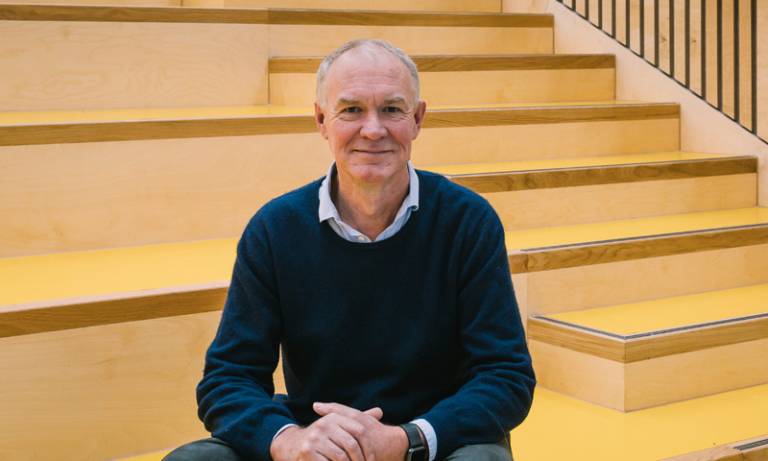Urbanisation, globalisation, automation, social and environmental disruption. All of these affect the way the built environment is created – and all set challenges The Bartlett needs to solve.

This urban scale will bring with it challenges – and require innovations – far beyond what we are used to dealing with. If the world is still urbanising, it has already globalised. We live on a single planet with a single scientific culture, a globally-interdependent economy, and, increasingly, a global social and cultural life. The world is also automating.
During the 19th century, more than three-quarters of the global population were tied to the land through agriculture– that figure is less than 40% today and, in the West, it’s just 2%. Automation is accelerating in the manufacturing industry and, more recently, in the services sector. Automation hasn’t hit the public imagination yet, but it will. Robotics and burgeoning artificial intelligence (AI) are starting to transform the way we work, and the way we make and run our cities.
Climate change, energy security, resource depletion, population movement and increasing inequalities have enormous disruptive potential. These, and the resurgent nationalism that we see today – which can be read as a reaction to the confluence of these factors – pose other existential threats to our way of life. These challenges all have built-environment dimensions that are so large that we will have to focus on them if we are to have any kind of impact.
So, over the past few years, The Bartlett has established four new institutes. First was the Institute for Global Prosperity (IGP), investigating alternative models to today’s dependency on growth and consumption. This was followed by the Institute for Digital Innovation in the Built Environment (iDIBE), looking at the impact of digital technologies on the way that we design, build and operate our cities.
In 2017, came The Bartlett Real Estate Institute (BREI), focused on the valuation of intangible aspects of the built environment – the value of design, sustainability, urban place-making or heritage, for example. The BREI has since launched a centre dedicated to the science behind designing educational spaces and a new Master’s programme in healthcare facilities.
By ascribing value to these, we aim to help ensure that investment can go towards the development of public goods. There are strong parallels here with our most recent launch: the Institute for Innovation and Public Purpose (IIPP). Founded by economist Professor Mariana Mazzucato, IIPP will investigate the role of government and the public sector in delivering innovation. In partnership with a series of high-profile organisations, it is developing a model of mission-oriented public policy, recognising that new ideas and their spillover effects take decades.
The IIPP will provide guidance on how public policy on innovation works best; the culture in which innovative findings can grow; the right kind of state structures to oversee research and collaboration with the private sector; and the right kind of metrics to evaluate fairly the progress of these entities. This work, devised with public policymakers themselves, is not currently undertaken by any other academic institute. Innovation, then, is political.
As automation removes manual and repetitive tasks, employment will shift towards high-value creation through design and the exercise of critical judgement. The UK’s industrial strategy – although largely geared towards mitigating the economic problems that Brexit will create – recognises this. As AI begins to reach the level of the human mind, humans will still have a role to play, but it will be their ability to collaborate in creative teams –including with AI and robots – that will be vital.
In London, as part of UCL, what we’re trying to do is create the conditions for the next generation of the economy. In 2017, we took possession of a new space for large-scale experimental and manufacturing facilities at Here East in the Queen Elizabeth Olympic Park. Built in a high-specification warehouse space 100m long, 40m wide and 10m high, it makes possible new collaborations between different parts of The Bartlett and UCL’s Engineering Sciences Faculty.
Environmental chambers and structural testing rigs sit alongside robotic cells and fabrication equipment. The space at Here East makes it possible for us to develop ways to intervene in the built environment at extreme scales, from full-scale construction components to tele-robotic engineering at the cellular level. This research and teaching is vital to advancing the skills in design, creativity and collaboration that future graduates of The Bartlett will need to resolve the challenges we face.
It was the late Sir Peter Hall, Professor of Planning and Regeneration at The Bartlett, who, in shaping the vision for the Thames Gateway, made sure that East London would become a strategic part of the city. It feels fitting to me that The Bartlett and UCL should be involved in the next stage of East London’s regeneration. Here East is our first step towards that.
Alan Penn, Professor of Architectural and Urban Computing
Dean, The Bartlett
UCL Faculty of the Built Environment
Photo by Tim Crocker
 Close
Close

